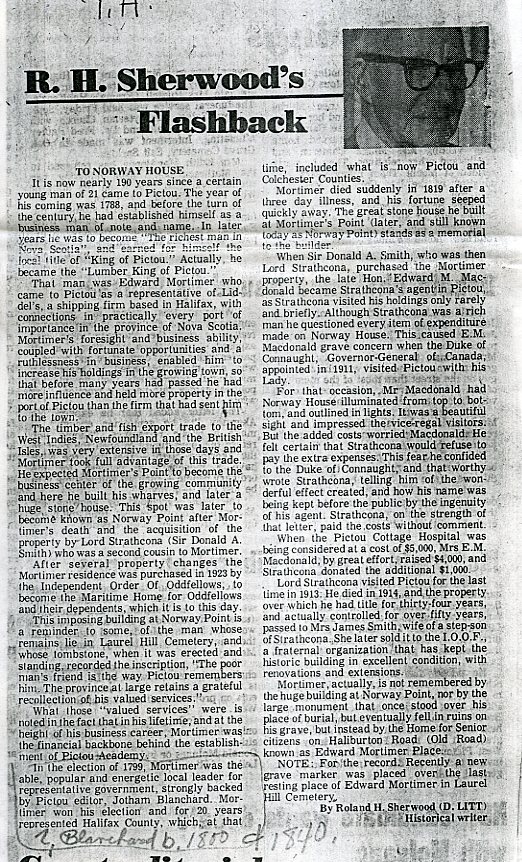
- H. Sherwood’s Flashback
To Norway House
It is now nearly 190 years since a certain young man of 21 came to Pictou. The year of his coming was 1788, and before the turn of the century he had established himself as a business man of note and name. In later years he was to become “The Richest man in Nova Scotia,” and earned for himself the local title of “King of Pictou.” Actually, he became the “Lumber King of Pictou.”
That man was Edward Mortimer who came to Pictou as a representative of Liddel’s a shipping firm based in Halifax, with connections in practically every port6of importance in the province of Nova Scotia. Mortimer’s foresight and business ability, coupled with fortunate opportunities and a ruthless in business, enabled him to increase his holdings in the growing town, so that before many years had passed he had more influence and held more property in the port of Pictou than the firm that had sent him to the town.
The timber and fish export trade to the West Indies, Newfoundland and the British Isles, was very extensive in those day and Mortimer took full advantage of this trade. He expected Mortimer’s Point to become the business center of the growing community and here he built his wharves, and later a huge stone house. This spot was later to become known as Norway Point after Mortimer’s death and the acquisition of the property by Lord Strathcona (Sir Donald A. Smith) who was a second cousin to Mortimer.
After several property changes the Mortimer residence was purchased in 1923 by the Independent Order Of Oddfellows and their dependents, which it is to this day.
This imposing building at Norway Point is a reminder to some, of the man whose remains lie in Laurel Hill Cemetery, and whose tombstone, when it was erect5ed and standing, recorded the inscription, “The poor man’s friend is the way Pictou remembers him. The province at lager retains grateful recollection of his valued services.”
What those “valued services” were is noted in the fact that in his lifetime, and at the height of his business career, Mortimer was the financial backbone behind the establishment of Pictou Academy.
In the election of 1799, Mortimer was the able, popular and energetic local leader for representative government, government, strongly backed by Pictou editor, Jotham Blanchard. Mortimer won his election and for 20 years represented Halifax County, which, at the time included what is now Pictou and Colchester Counties.
Mortimer died suddenly in 1819 after a three day illness, and his fortune seeped quickly away. The great stone house he built at Mortimer’s point (later and still known today as Mortimer’s point) stands as a memorial to the builder.
When Sir Donald A. Smith, who was then Lord Strathcona, purchased the Mortimer property, the late Hon. Edward M. MacDonald became Strathcona’s agent in Pictou, as Strathcona visited his holdings only rarely and briefly. Although Strathcona was a rich man he questioned every item of expenditure made on Norway House. This caused E.M. MacDonald grave concern when the Duke of Connaught, Governor- General of Canada, appointed in 1911, visited Pictou with his Lady.
For that occasion, Mr. MacDonald had Norway House illuminated from top to bottom, and outlined in lights. It was a beautiful sight and impressed the vice-regal visitors. But the added costs worried MacDonald. He pays the extra expenses. This fear he confided wrote Strathcona, telling him of the wonderful effect created, and how his name was being kept before the public by the ingenuity of his agent. Strathcona, on the strength of that letter, paid the costs without comment.
When the Pictou Cottage Hospital was being considered at a cost of $5,000, Mrs. E. M. MacDonald, by great effort, raising $4000, and Strathcona donated the additional $1000.
Lord Strathcona visited Pictou for the last time in 1913. He died in 1914, and the property over which he had title for thirty- four years, and actually controlled for over fifty years, passed to Mrs. James Smith, wide of a step-son of Strathcona. She later sold it to the I.O.O.F., a fraternal organization that has kept the historical building in excellent condition, with renovations and extensions.
Mortimer, actually, is not remembered by the huge building at Norway Point or by the large monument that once stood over his place of burial, but eventually fell in ruins on his grave, but instead by the Home for Senior citizens on Halliburton Road (Old Road) known as Edward Mortimer Place.
NOTE: For the record. Recently a new grave marker was placed over the last resting place of Edward Mortimer in Laurel Hill Cemetery.
By Roland H. Sherwood (D. LITT)
Historical Writer
Vault Roland Sherwood File
| File number: | 01-597.14 |
| Contributor: |
|
| Tags: | Norway, Edward Mortimer, Sir Donald A Smith, Jotham Blanchard, E.M. MacDonald, James Smith, Strathacona, Roland sherwood, Pictou, Pictou Academy |
| Views: | 1018 |
| Uploaded on: | September 21, 2016 |